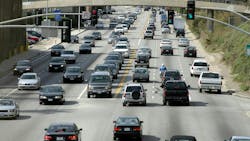BIL Funding Could be Reduced as Inflation Rises
Higher costs reduce what can be bought with the money allocated by transportation spending bills. The Bipartisan Infrastructure Law (BIL) includes $673.8 billion in transportation funding for roads, bridges, transit, airports, ports, and rail. Should highway construction costs rise above their level when BIL was signed in 2021, what can be bought with the funds in each fiscal year will decline.
Of that $673.8 billion, the largest share ($379.3 billion, or 56%) is for highway infrastructure, with roughly 20% of the total highway allocation to be distributed in each of the five fiscal years from 2022 through 2026.
Two scenarios from the U.S. Department of Transportation (USDOT) look at the likelihood of a decline in funding.
The first scenario assumes construction costs continue to rise at their current rate using the average annual growth from the last two years (2021 and 2022), called the High Inflation Scenario. Under this scenario, only $224.2 billion can be bought with the $379.3 billion allotted for highways. In other words, only 60% of what could have been bought in 2021, when BIL was signed, can be bought over the five years from 2022 through 2026; that is a 40% reduction.
The second scenario, the Modest Inflation Scenario, assumes a more modest growth in construction costs equal to the average annual growth in 2019 and 2021. Under this more modest growth scenario, $260.5 billion can be bought with the $379.3 billion allocated for highways due to increased highway construction costs. This is a 31% reduction in what could have been constructed in 2021 when highway construction cost less.
What can be bought today with BIL funds allocated to transportation in 2021 is significantly less than the dedicated amount due to recent, unprecedented increases in highway construction costs. Highway construction costs rose an unprecedented 26% in 2022; significantly more than the previous all-time annual increase of 20% in 2005, according to USDOT.
The most recent data, through the third quarter of 2023, show continued growth, with construction costs rising 25% from the first quarter of 2022 to the first quarter of 2023 and 5% from the first to the third quarter of 2022. The growth in construction costs reduces the amount of highway infrastructure that can be bought today versus what could have been purchased prior to the price increases.
Increases in crude oil, which is used to produce asphalt, contributed to highway construction cost increases. U.S. crude oil increased 594%, from a low of $16.55 per barrel in April 2020 to the second highest price on record of $114.84 per barrel in June 2022.
As a result, asphalt was the top contributor to quarterly increases in the National Highway Construction Cost Index (NHCCI) from the last quarter of 2021 through the third quarter of 2022. Crude oil prices have fallen since the June 2022 high but have risen steadily since the beginning of 2024, which suggests construction costs may rise further.
Supply chain issues additionally contributed to the rise in highway construction costs. Supply chain issues began in 2020 when COVID-19 caused temporary and permanent business closures and increased demand for durable goods. This, in turn, caused material prices to rise.
----------------------------------------------------------------
Source: U.S. Department of Transportation
